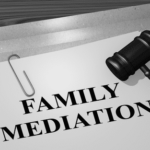While mediation has been a long-standing alternative for people involved in residential responsibility related actions, individuals could only use it if they could afford it. This began to change approximately ten years ago. In 2007, the Legislature appropriated funds to support the Family Mediation Pilot Project. The mission of this pilot project was to “explore a procedure to provide a high quality, impartial, and efficient forum for resolving disputed custody and visitation matters through mediation.” Its goal was to “improve the lives of families and children who appear before the court by trying to resolve custody and visitation disputes through mediation in order to minimize family conflict, encourage shared decision-making, and support healthy relationships and communication among family members.” The Family Mediation Pilot Project was very successful in meeting its objectives and was initiated in January of 2014 by the North Dakota Supreme Court.
The Rule
North Dakota Rules of Court 8.1 deals exclusively with the Family Mediation Program. Rule 8.1 defines mediation as a “process by which a non-judicial neutral mediator facilitates communication between parties to assist the parties in reaching voluntary decisions related to their dispute.” The mission and goal of the Family Mediation Program are nearly identical to the mission and goal identified when this was just a pilot project.
The Referral
Once your action is filed, then your case will be referred to the Family Mediation Program Administrator by the district court within 10 days. The Family Mediation Program Administrator ensures your case is sent through the Family Mediation Program.
The district court clerk is required to refer any action involving a dispute or unresolved issue regarding parental rights and responsibilities, cases involving grandparent visitation, divorces involving minor children, separations involving minor children, paternity actions, or guardianships that involve any of these issues to the Family Mediation Program.
If you are seeking a modification of your judgment, then your case may still be referred to the Family Mediation Program. Specifically, if you are seeking to modify parental rights and responsibilities, requesting permission to move out of the State of North Dakota, or if you are seeking grandparent visitation. The only caveat is that if you are seeking to modify parental rights and responsibilities you will only be referred to the Family Mediation Program after the court has determined a prima facie case has been established, under North Dakota Century Code Section 14-09-06.6, and the Court believes mediation will be useful.
The district court clerk is not the only individual who can refer your case to the Family Mediation Program. Your parental rights and responsibilities proceeding may be referred to the Family Mediation Program, at any time, by a district court judge or judicial referee, as long as it is not excluded from the program.
The Process
Once you receive an Order and Schedule for mediation assigning you to a qualified mediator, then you will contact that mediator to set up your pre-mediation orientation session and mediation session. Between the pre-mediation orientation session and mediation session, you are entitled to six free hours of mediation.
At the pre-mediation orientation session, the mediator will discuss the process with you, including your goals, expectations, how to prepare, the role of the Court, attorneys, and other experts, and any other relevant requirements.
Undoubtedly, you will be asked if you are bringing your attorney to mediation. This is a decision only you can make, but you should only do so after discussing the pros and cons with your attorney. I know it may sound a little self-serving, but I truly believe it’s best that parties proceed to mediation with their attorneys. Your attorney can provide you with support, advice, suggestions, and most importantly, insight into what the Court may do in your particular situation, based on their legal experience and opinion. Remember, the mediator’s goal is to find a meeting of the minds between yourself and the opposing party, but they do not represent you.
In mediation, you will discuss your entire case. You’ll explain the reasons supporting your position, and proposals, but don’t worry about showing your hand because the mediation process is completely confidential. This means that neither party can testify about what was said or occurred in mediation, and the mediator cannot be called to testify. The mediator will use the information that each side has provided him with to try and get the parties to enter into a mutual agreement. In my experience, mediation has been successful the vast majority of the time. It provides parties with an opportunity to have a voice in their agreement, and it also provides them with an opportunity to avoid the acrimonious and emotionally taxing litigation process.
If the parties are able to reach an agreement, then the attorneys will work together to draft up an agreement to file with the Court. However, each party has seven days to reconsider the decisions made in mediation. The mediator will file a letter indicating that the parties reached an agreement on all issues after this seven day period of time has elapsed. If the parties are unable to reach a complete agreement, then the case will be put on for trial and the Court will render a decision on all pending issues. In this situation, the mediator will file a letter with the Court indicating that a partial agreement was reached or that no agreement was reached.
Conclusion
The Family Mediation Program is an integral part of a large number of family law cases. At SW&L in Fargo, we have attorneys who handle exclusively family law cases, including cases referred to the North Dakota Family Mediation Program. If you have a family law issue that you would like to discuss, please do not hesitate to call 701-297-2890.
The information contained in this article and on this website is for informational purposes only and not for the purpose of providing legal advice.










